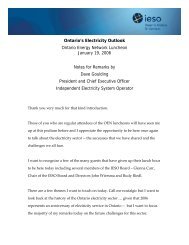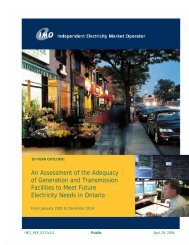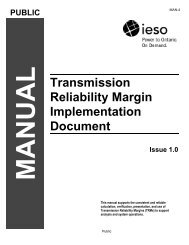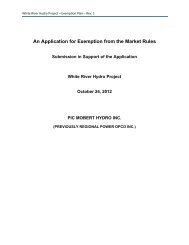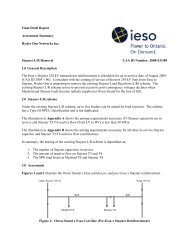Manby H1L15 Breaker Incident - July 5, 2010 - IESO
Manby H1L15 Breaker Incident - July 5, 2010 - IESO
Manby H1L15 Breaker Incident - July 5, 2010 - IESO
Create successful ePaper yourself
Turn your PDF publications into a flip-book with our unique Google optimized e-Paper software.
<strong>Manby</strong> <strong>H1L15</strong> <strong>Breaker</strong> <strong>Incident</strong> - <strong>July</strong> 5, <strong>2010</strong>3. Description of the Event3. Description of the EventAt approximately 15:40 Eastern Standard Time (EST) on <strong>July</strong> 5, <strong>2010</strong> the <strong>Manby</strong> West<strong>H1L15</strong> oil-filled breaker suffered an explosive internal failure, spreading debris and oil over150 feet in diameter and causing the breaker to catch fire. Oil spray and debris from thebreaker was attributed to subsequent faults on several connected transmission lines and busbarsections in the <strong>Manby</strong> East and West yards, resulting in a total load interruption of over1550 MW and affecting over 240,000 people in the Greater Toronto Area (GTA). Of the1550 MW that was automatically removed from service (ARFS), 902 MW were removed byconfiguration while the remaining 648 MW were in response to the fault surge as a result ofcustomer-owned, low-voltage protection operation within surrounding local distributioncentres.There was no adverse weather occurring in the GTA at the time of the incident. All areavoltages and thermal ratings were being respected under normal operating conditions. Withthe exception of a forced outage to a <strong>Manby</strong> East 230 kV capacitor, there were no otherongoing outages in either of the <strong>Manby</strong> yards.At 15:40:35 EST 230 kV circuit R15K (Richview – <strong>Manby</strong> West) and the <strong>Manby</strong> H1 buswere ARFS following normal line and bus protections as a result of the phase-to-ground faulton the <strong>Manby</strong> West <strong>H1L15</strong> breaker. Over the course of approximately 3.6 seconds, fiveadditional faults removed the <strong>Manby</strong> West A1 bus, K23C, <strong>Manby</strong> East H2 Bus, R1K, and the<strong>Manby</strong> East A2 bus from service upon receipt of normal bus and line protections.The resulting load loss caused the <strong>IESO</strong> Area Control Error (ACE) to increase to a positive1580 MW. In addition, multiple 230 and 500 kV stations in Southern Ontario saw busvoltages rise as the need for reactive support was diminished by the loss of load. <strong>IESO</strong>operators took immediate action in manually dispatching generation and reactive resources toreduce ACE and system voltages back to pre-contingency levels. MISO and NYISO sawincreases of 725 MW and 690 MW into their systems on the Michigan and New Yorkinterfaces respectively. System voltages were restored to normal within ten minutes. Withintwelve minutes, intertie flows were back on schedule as ACE was reduced to 0 MW.Load restoration efforts began immediately after system conditions were deemed acceptable.As Hydro One required visual inspection of the faulted equipment prior to making itavailable for use, load transfers were conducted in order to re-supply the GTA load fromalternate sources that were unaffected by the incident. This transfer capability can be seen inFigure 3 on the following page. With the exception of one load distribution station andseveral feeders at another, all load removed by the contingency was restored through loadtransfers in under two hours from the time the incident occurred.Load transfers were expedited by utilizing spare capacity from generating units at thePortlands Energy Centre. At the time of the fault, Portlands was in-service generatingapproximately 75% of its rated capacity. Once load transfers commenced, <strong>IESO</strong> manuallyOctober 20, <strong>2010</strong> Public 7



